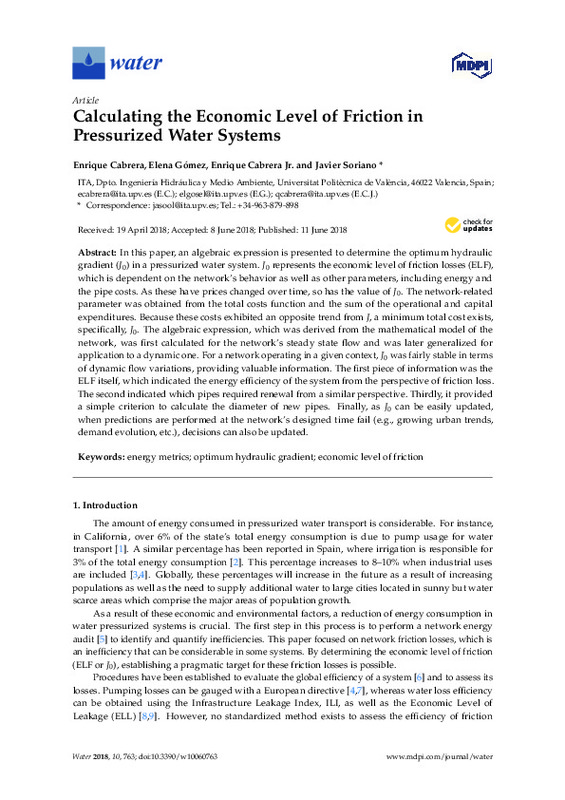JavaScript is disabled for your browser. Some features of this site may not work without it.
Buscar en RiuNet
Listar
Mi cuenta
Estadísticas
Ayuda RiuNet
Admin. UPV
Calculating the Economic Level of Friction in Pressurized Water Systems
Mostrar el registro sencillo del ítem
Ficheros en el ítem
| dc.contributor.author | Cabrera Marcet, Enrique
|
es_ES |
| dc.contributor.author | Gomez Selles, Elena
|
es_ES |
| dc.contributor.author | Cabrera Rochera, Enrique
|
es_ES |
| dc.contributor.author | Soriano Olivares, Javier
|
es_ES |
| dc.date.accessioned | 2019-05-11T20:04:29Z | |
| dc.date.available | 2019-05-11T20:04:29Z | |
| dc.date.issued | 2018 | es_ES |
| dc.identifier.issn | 2073-4441 | es_ES |
| dc.identifier.uri | http://hdl.handle.net/10251/120365 | |
| dc.description.abstract | [EN] In this paper, an algebraic expression is presented to determine the optimum hydraulic gradient (J(0)) in a pressurized water system. J(0) represents the economic level of friction losses (ELF), which is dependent on the network's behavior as well as other parameters, including energy and the pipe costs. As these have prices changed over time, so has the value of J(0). The network-related parameter was obtained from the total costs function and the sum of the operational and capital expenditures. Because these costs exhibited an opposite trend from J, a minimum total cost exists, specifically, J(0). The algebraic expression, which was derived from the mathematical model of the network, was first calculated for the network's steady state flow and was later generalized for application to a dynamic one. For a network operating in a given context, J(0) was fairly stable in terms of dynamic flow variations, providing valuable information. The first piece of information was the ELF itself, which indicated the energy efficiency of the system from the perspective of friction loss. The second indicated which pipes required renewal from a similar perspective. Thirdly, it provided a simple criterion to calculate the diameter of new pipes. Finally, as J(0) can be easily updated, when predictions are performed at the network's designed time fail (e.g., growing urban trends, demand evolution, etc.), decisions can also be updated. | es_ES |
| dc.language | Inglés | es_ES |
| dc.publisher | MDPI AG | es_ES |
| dc.relation.ispartof | Water | es_ES |
| dc.rights | Reconocimiento (by) | es_ES |
| dc.subject | Energy metrics | es_ES |
| dc.subject | Optimum hydraulic gradient | es_ES |
| dc.subject | Economic level of friction | es_ES |
| dc.subject.classification | MECANICA DE FLUIDOS | es_ES |
| dc.subject.classification | INGENIERIA HIDRAULICA | es_ES |
| dc.title | Calculating the Economic Level of Friction in Pressurized Water Systems | es_ES |
| dc.type | Artículo | es_ES |
| dc.identifier.doi | 10.3390/w10060763 | es_ES |
| dc.rights.accessRights | Abierto | es_ES |
| dc.contributor.affiliation | Universitat Politècnica de València. Departamento de Ingeniería Hidráulica y Medio Ambiente - Departament d'Enginyeria Hidràulica i Medi Ambient | es_ES |
| dc.description.bibliographicCitation | Cabrera Marcet, E.; Gomez Selles, E.; Cabrera Rochera, E.; Soriano Olivares, J. (2018). Calculating the Economic Level of Friction in Pressurized Water Systems. Water. 10(6):1-21. https://doi.org/10.3390/w10060763 | es_ES |
| dc.description.accrualMethod | S | es_ES |
| dc.relation.publisherversion | https://doi.org/10.3390/w10060763 | es_ES |
| dc.description.upvformatpinicio | 1 | es_ES |
| dc.description.upvformatpfin | 21 | es_ES |
| dc.type.version | info:eu-repo/semantics/publishedVersion | es_ES |
| dc.description.volume | 10 | es_ES |
| dc.description.issue | 6 | es_ES |
| dc.relation.pasarela | S\364470 | es_ES |








